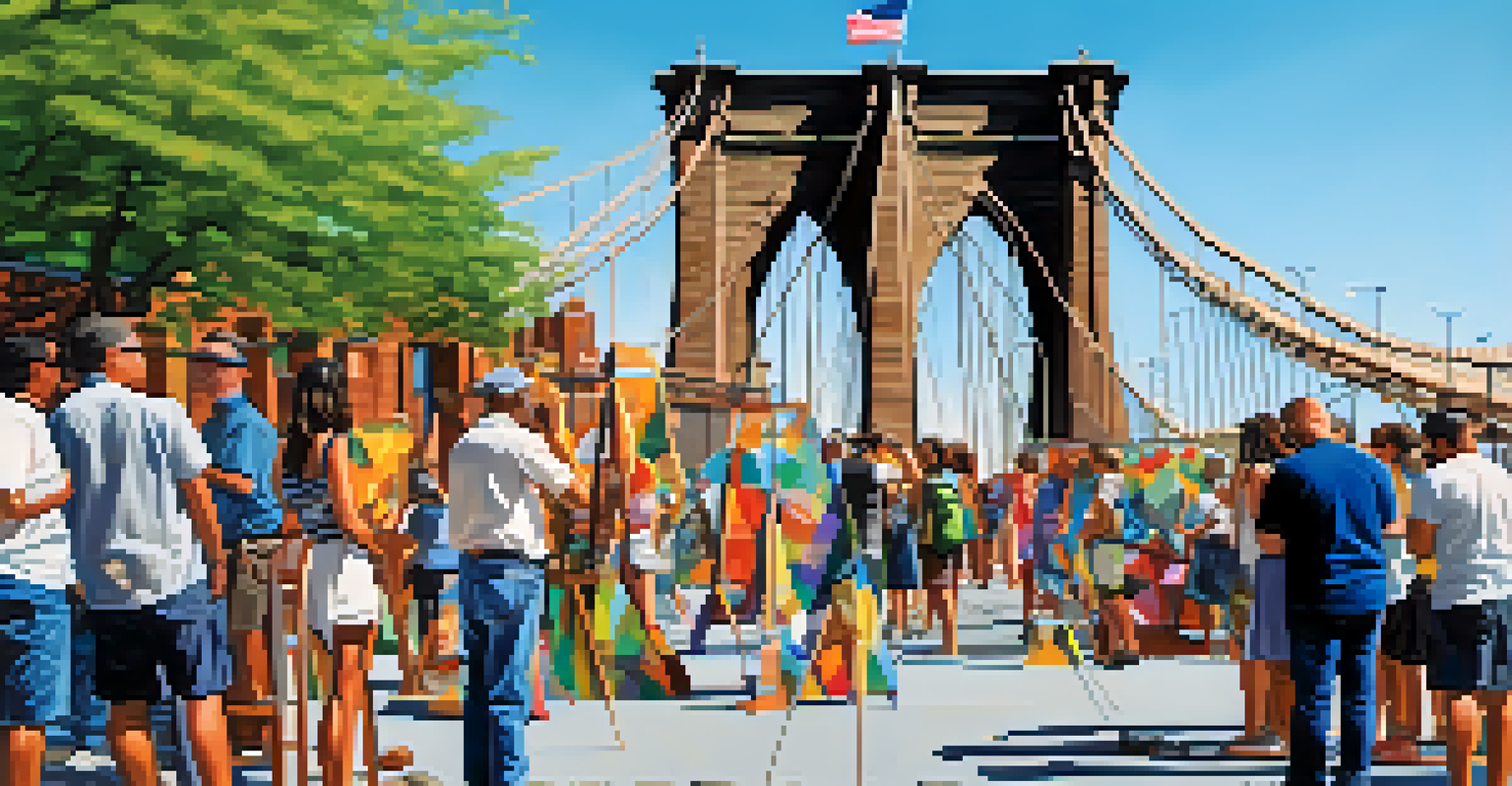The Social Impact of NYC's Waterfront Spaces on Communities

Introduction: Understanding NYC's Unique Waterfront Spaces
New York City is famous for its bustling streets, towering skyscrapers, and vibrant cultural scene, but its waterfront spaces are equally important. These areas, which include parks, piers, and promenades, play a crucial role in enhancing community life. They provide not just recreational opportunities but also serve as vital connectors among diverse neighborhoods.
The water is the most important thing in the city. It’s the lifeblood of the city and it connects us all.
The waterfront is a melting pot of cultures, offering a shared space for residents and visitors alike. From the serene pathways along the Hudson River to the lively markets at Brooklyn Bridge Park, these areas invite everyone to engage with each other. This accessibility fosters a sense of belonging and community pride, which can be transformative for urban living.
In exploring the social impact of these waterfront spaces, we can better understand their role in shaping the fabric of New York City. Let's dive into how these areas influence community interactions, health, and local economies.
Promoting Community Interaction Through Waterfront Spaces
One of the most significant benefits of NYC's waterfront spaces is their ability to encourage community interaction. These areas often host events, markets, and festivals that bring people together, creating opportunities for friendships and connections. For instance, summer concerts or food festivals can attract diverse crowds, allowing individuals to bond over shared experiences.

Moreover, waterfront spaces serve as informal gathering spots where residents can meet, relax, and socialize. Whether sitting on a bench, enjoying a picnic, or participating in a yoga class, the waterfront promotes a sense of community ownership. This casual interaction can strengthen social networks and enhance community resilience.
Community Interaction is Key
NYC's waterfront spaces foster community interaction through events and informal gatherings, creating a sense of belonging among residents.
As people gather and interact, they also share ideas and resources, which can lead to collaborative community projects. By fostering a culture of engagement, waterfront spaces become catalysts for social cohesion, making urban life more vibrant and inclusive.
Enhancing Mental and Physical Health Through Nature
Access to green spaces and waterfronts has been linked to numerous health benefits, both mental and physical. Studies show that spending time in nature can reduce stress, improve mood, and enhance overall well-being. NYC's waterfront parks provide a natural escape from the concrete jungle, offering residents a place to unwind and recharge.
Parks are not only a place to play; they are a place to connect with nature, community, and ourselves.
Engaging in physical activities like walking, running, or biking along the waterfront can also promote a healthier lifestyle. Many of these spaces are designed to incorporate fitness trails, play areas, and sports facilities, encouraging residents to stay active. This combination of nature and exercise can lead to long-term health improvements for the community.
In addition, the calming presence of water has a unique therapeutic effect. The soothing sounds of waves and the sight of the skyline can create a peaceful atmosphere that supports mental clarity and relaxation. This connection to nature is essential for urban dwellers navigating the challenges of city life.
Economic Opportunities Created by Waterfront Development
The development of waterfront spaces is not just about aesthetics; it also provides significant economic opportunities for local communities. Businesses that thrive in these areas, such as restaurants, shops, and recreational facilities, can create jobs and stimulate local economies. For example, waterfront dining options often attract both locals and tourists, boosting sales and employment.
Moreover, waterfront developments can increase property values in surrounding neighborhoods. As these spaces become more desirable, the demand for housing rises, leading to potential investment in community infrastructure. This economic uplift can further enhance the quality of life for residents, creating a positive feedback loop.
Health Benefits from Nature Access
Access to waterfront parks promotes both mental and physical health by providing natural spaces for relaxation and physical activities.
However, it’s crucial to ensure that this economic growth benefits all community members. Implementing inclusive practices and fostering local entrepreneurship can help maintain the unique character of neighborhoods while supporting economic development.
Cultural Expression and Identity Along the Waterfront
NYC's waterfront spaces serve as canvases for cultural expression, showcasing the diversity of the city's inhabitants. Festivals, art installations, and performances held in these areas often reflect the unique identities of local communities. This cultural vibrancy not only enriches the waterfront experience but also fosters pride among residents.
Art plays a vital role in connecting people to their environment and each other. Public art installations along the waterfront can spark conversations and inspire creativity. By celebrating local artists and traditions, these spaces become platforms for cultural exchange and understanding.
Furthermore, waterfront events often highlight the city's rich history and heritage, allowing residents to engage with their past. This connection to culture and history can deepen community bonds and enhance the sense of place, making the waterfront a living tapestry of New York's diverse narratives.
Environmental Awareness and Sustainability Initiatives
As urban centers grapple with climate change, NYC's waterfront spaces are increasingly becoming sites for environmental awareness and sustainability initiatives. These areas often incorporate green infrastructure, such as rain gardens and permeable pavements, which help manage stormwater and reduce flooding. This commitment to sustainability not only protects the environment but also educates the community about ecological responsibility.
Educational programs and workshops hosted at waterfront spaces can empower residents to take an active role in environmental stewardship. By involving the community in conservation efforts, such as clean-up days or tree planting, residents foster a sense of responsibility for their local environment. This collective action can lead to lasting change and a more sustainable future.
Economic Growth and Inclusivity
Waterfront development boosts local economies while highlighting the importance of inclusive practices to benefit all community members.
Additionally, enhancing natural habitats along the waterfront can support biodiversity, making these spaces not only beautiful but ecologically vital. By promoting an understanding of the interconnectedness of urban and natural environments, waterfront developments can inspire a more sustainable mindset among community members.
Challenges and Opportunities for Future Waterfront Development
While NYC's waterfront spaces offer numerous benefits, they also face challenges that must be addressed for future development. Issues such as gentrification, accessibility, and climate resilience are critical considerations for planners and local governments. Finding a balance between development and community needs is essential to ensure that these spaces remain inclusive and beneficial for all.
Engaging community members in the planning and decision-making process is crucial. By involving residents in discussions about the future of their waterfront, stakeholders can better understand local concerns and aspirations. This participatory approach can lead to more tailored solutions that reflect the unique character of each community.

As we look to the future, the potential for waterfront spaces to continue evolving is immense. By prioritizing sustainability, inclusivity, and cultural expression, NYC can harness the power of its waterfront to create vibrant, resilient communities for generations to come.